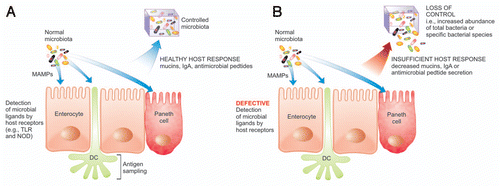Figures & data
Figure 1 Disrupting microbial function. (A) In a healthy gut bacteria work synergistically, with each bacteria being an integral link in the production of metabolites that are ultimately used by the host, such as vitamins and fatty acids. (B) Host inflammation targets certain groups of bacteria resulting in a loss of core members and core functions, therefore reduced metabolic activity and a deprived host.

Figure 2 Sensing and controlling the microbiota. (A) The appropriate detection and antigen sampling of the microbiota through many mechanisms results in a healthy host response leading to control of the microbiota. (B) Defective detection of the microbiota and an insufficient host response leads to a loss of control of the microbiota, including the expansion of the total bacteria or specific bacterial populations. DC, dendritic cell; MAMP, microbe associated molecular pattern; IgA, immunoglobulin A; TLR, toll-like receptor; NOD, nucleotide-binding oligomerization domain.

Table 1 Examples of changes in host physiology resulting in changes in the gut microbiota